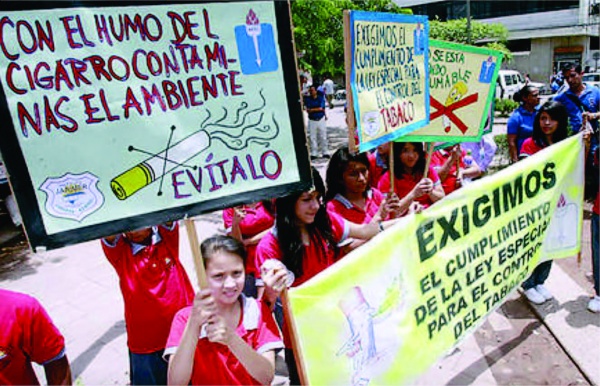Special Act to Regulate Tobacco
In 2011, Honduras enacted the Special Tobacco Control Law regulating tobacco production, distribution, marketing, imports, consumption, advertising and promotion, and sponsorship, with the goal of reducing and gradually eradicating tobacco use. An inter- agency committee was formed to draft the law and guide it through the enactment process, and educate the public about its provisions.
Meets the criteria established under Health in All Policies:
- Political commitment. The legislature enacted the law, which is supported by a strong presidential mandate. The Honduran Institute for the Prevention of Alcoholism, Drug Addiction and Drug Dependence (IHADFA) is responsible for implementing the law.
- Separate structure. An inter-agency committee (CONAPROCTA) was formed to draft the law. Coordinated by IHADFA, the committee is comprised of the following institutions: the Honduran Anti-smoking Alliance; National Alliance against Drugs (ANCOD); Action for Tobacco Free Environments (APALTA); Computer Science and Legislative Studies Center of the National Congress (CIEL/CN); the Secretariats of Labor and Social Security (STSS), Finance (SEFIN), and Industry and Trade (SEIC); the National Children's Board (PANI); Honduran Cancer Association; and the National Commission for the Control of Tobacco (CONACTA). The committee designed a two-pronged strategy for enactment: (1) law and policy and (2) dissemination.
- Participation of other sectors. In addition to the health sector and the National Congress, other sectors were involved in the law's implementation: Secretariat of Natural Resources and Environment (CERNA); Secretary of industry and Commerce (SIC); Ministry of Agriculture and Livestock (SAC); Office of the Special Prosecutor for the Environment; National Institute for Women (INAM), National Institute for Heart and Lung Disease, the Autonomous National University of Honduras, Honduras Medical School, and the Natural Resources Office.
- Separate budget. While no separate budget was allocated for the law itself, each one of the relevant agencies allocates resources for its implementation.
- Focus on reducing inequity. The law is intended to reduce the health gradient between groups and impact communities with high levels of tobacco use.
- Intersectoral action. The law regulates tobacco marketing, advertising, sales, possession, and use. All of the relevant institutions were involved in drafting the law, whether by providing scientific evidence, engaging in political advocacy, designing and following up on environmental protection policies, or promoting the anti- tobacco law. An inter-agency plan as well as sector- or agency-specific plans were drafted to publicize the law.
- Public policy. Through their implementation plans, every sector will have an impact on reducing tobacco use, control of tobacco products, and promoting a healthier lifestyle.
- Evidence of results. The plan includes compiling scientific evidence of the results. An evaluation is currently being designed and IHADFA gathers data on a regular basis through focus groups.
- Social participation. While no information was provided on civil society's role in the drafting, negotiation, and enactment of the law, public participation will play a key role in implementation and compliance.
